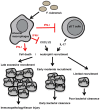Does Type I Interferon Limit Protective Neutrophil Responses during Pulmonary Francisella Tularensis Infection?
- PMID: 25101094
- PMCID: PMC4107939
- DOI: 10.3389/fimmu.2014.00355
Does Type I Interferon Limit Protective Neutrophil Responses during Pulmonary Francisella Tularensis Infection?
Keywords: Francisella tularensis; immune evasion; mucosal immunity; neutrophil; type I interferon.
Figures

Similar articles
-
Interleukin-17 protects against the Francisella tularensis live vaccine strain but not against a virulent F. tularensis type A strain.Infect Immun. 2013 Sep;81(9):3099-105. doi: 10.1128/IAI.00203-13. Epub 2013 Jun 17. Infect Immun. 2013. PMID: 23774604 Free PMC article.
-
IL-10 restrains IL-17 to limit lung pathology characteristics following pulmonary infection with Francisella tularensis live vaccine strain.Am J Pathol. 2013 Nov;183(5):1397-1404. doi: 10.1016/j.ajpath.2013.07.008. Epub 2013 Sep 3. Am J Pathol. 2013. PMID: 24007881 Free PMC article.
-
Infection with Francisella tularensis LVS clpB leads to an altered yet protective immune response.Infect Immun. 2013 Jun;81(6):2028-42. doi: 10.1128/IAI.00207-13. Epub 2013 Mar 25. Infect Immun. 2013. PMID: 23529616 Free PMC article.
-
Host-pathogen interactions and immune evasion strategies in Francisella tularensis pathogenicity.Infect Drug Resist. 2014 Sep 18;7:239-51. doi: 10.2147/IDR.S53700. eCollection 2014. Infect Drug Resist. 2014. PMID: 25258544 Free PMC article. Review.
-
Uncovering the components of the Francisella tularensis virulence stealth strategy.Front Cell Infect Microbiol. 2014 Mar 7;4:32. doi: 10.3389/fcimb.2014.00032. eCollection 2014. Front Cell Infect Microbiol. 2014. PMID: 24639953 Free PMC article. Review.
Cited by
-
Type I Interferon-Mediated Regulation of Antiviral Capabilities of Neutrophils.Int J Mol Sci. 2021 Apr 29;22(9):4726. doi: 10.3390/ijms22094726. Int J Mol Sci. 2021. PMID: 33946935 Free PMC article. Review.
-
Harnessing Mechanistic Knowledge on Beneficial Versus Deleterious IFN-I Effects to Design Innovative Immunotherapies Targeting Cytokine Activity to Specific Cell Types.Front Immunol. 2014 Oct 30;5:526. doi: 10.3389/fimmu.2014.00526. eCollection 2014. Front Immunol. 2014. PMID: 25400632 Free PMC article. Review.
-
Mysteries of type I IFN response: benefits versus detriments.Front Immunol. 2015 Jan 28;6:21. doi: 10.3389/fimmu.2015.00021. eCollection 2015. Front Immunol. 2015. PMID: 25674090 Free PMC article. No abstract available.
-
The secRNome of Listeria monocytogenes Harbors Small Noncoding RNAs That Are Potent Inducers of Beta Interferon.mBio. 2019 Oct 8;10(5):e01223-19. doi: 10.1128/mBio.01223-19. mBio. 2019. PMID: 31594810 Free PMC article.
-
The immune response to Francisella tularensis.Front Microbiol. 2025 Apr 25;16:1549343. doi: 10.3389/fmicb.2025.1549343. eCollection 2025. Front Microbiol. 2025. PMID: 40351308 Free PMC article. Review.
References
-
- Singh A, Rahman T, Malik M, Hickey AJ, Leifer CA, Hazlett KR, et al. Discordant results obtained with Francisella tularensis during in vitro and in vivo immunological studies are attributable to compromised bacterial structural integrity. PLoS One (2013) 8(3):e58513.10.1371/journal.pone.0058513 - DOI - PMC - PubMed
Publication types
Grants and funding
LinkOut - more resources
Full Text Sources
Other Literature Sources

